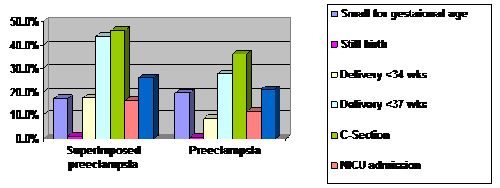Gaining Insight Into Preeclampsia Versus Superimposed Preeclampsia
Chronic hypertension plagues as many as 5% of pregnancies and can result in such adverse perinatal outcomes as preterm birth and fetal death. Further complications can present among women with chronic hypertension who develop superimposed preeclampsia, yet data on perinatal outcomes for such women are sparse.
Chronic hypertension plagues as many as 5% of pregnancies and can result in such adverse perinatal outcomes as preterm birth and fetal death. Further complications can present among women with chronic hypertension who develop superimposed preeclampsia, yet data on perinatal outcomes for such women are sparse.
To better understand the perinatal outcomes in women with preeclampsia, chronic hypertension, and chronic hypertension with superimposed preeclampsia, Dr Methodius G. Tuuli of the division of maternal-fetal medicine and ultrasound in the department of obstetrics and gynecology at Washington University School of Medicine at St. Louis and colleagues conducted a retrospective cohort study of women with chronic hypertension (n = 1032), superimposed preeclampsia (n = 489), preeclampsia (n = 4217), and control participants (n = 57,103). Control participants had neither chronic hypertension nor preeclampsia. Only women with singletons were included.
The researchers found that, in comparison with the control group, women with preeclampsia were significantly more likely to have an infant who was small for gestational size, abruption, preterm delivery at 34 weeks’ gestation or less, preterm delivery at 37 weeks’ gestation or less, cesarean delivery, neonatal intensive care unit admission for their infants, and prolonged hospital stay compared with control subjects. Interestingly, the risk of still birth was significantly lower in the preeclampsia group as compared to the control group. Patients with chronic hypertension without preeclampsia and those with superimposed preeclampsia showed similar risks of adverse outcomes when compared to their control counterparts (Figure).
Figure. Outcomes in women with preeclampsia versus superimposed preeclampsia

“Our data indicate that women with chronic hypertension, with or without superimposed preeclampsia, and preeclampsia are at a significantly increased risk of several adverse perinatal outcomes,” Tuuli and colleagues concluded.
“Women with superimposed preeclampsia have elevated risks of intervention-related events compared with women with preeclampsia,” they added. “This may be the result of earlier disease onset, more severe disease, or aggressive management. Although further research is needed to identify the optimal timing of delivery in women with superimposed preeclampsia, consideration of expectant management of early onset superimposed preeclampsia is reasonable in the absence of contraindications.”
More Information
Reference
- Tuuli MG, Rampersad R, Stamilio D, et al. Perinatal outcomes in women with preeclampsia and superimposed preeclampsia: do they differ? [http://www.ncbi.nlm.nih.gov/pubmed/21419381] Am J Obstet Gynecol. 2011; Mar 16 [epub].
S1E4: Dr. Kristina Adams-Waldorf: Pandemics, pathogens and perseverance
July 16th 2020This episode of Pap Talk by Contemporary OB/GYN features an interview with Dr. Kristina Adams-Waldorf, Professor in the Department of Obstetrics and Gynecology and Adjunct Professor in Global Health at the University of Washington (UW) School of Medicine in Seattle.
Listen
Study shows a healthy prenatal diet could be upstream obesity prevention strategy
December 26th 2024"Our findings support the recommendation of a healthy diet based on the current guidelines (as measured by the HEI) during pregnancy, since it may reduce patterns of infant growth outside reference ranges."
Read More
Early pregnancy cannabis use high in states with recreational legalization
November 11th 2024A population-based time-series analysis California before, during and after legalization show a rising trend in women using cannabis while pregnancy especially when the state has legalized the drug.
Read More
